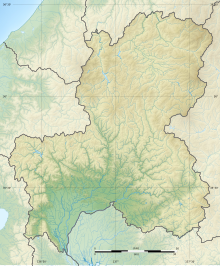
Back معركة سيكيغاهارا Arabic Batalla de Sekigahara AST Sekigahara döyüşü (1600) Azerbaijani سکیقاهارا دؤیوشو AZB Битка при Секигахара Bulgarian Batalla de Sekigahara Catalan Bitva u Sekigahary Czech Schlacht von Sekigahara German Batalo de Sekigahara Esperanto Batalla de Sekigahara Spanish
| Commanders of Eastern Army (Tokugawa Force) | |
|---|---|
| Tokugawa Ieyasu (head of the alliance): 30,000 men | |
| Maeda Toshinaga | |
| Date Masamune | |
| Katō Kiyomasa: 3,000 men | |
| Fukushima Masanori: 6,000 men | |
| Hosokawa Tadaoki: 5,000 men | |
| Numata Jakō | |
| Asano Yoshinaga: 6,510 men | |
| Ikeda Terumasa: 4,560 men | |
| Kuroda Nagamasa: 5,400 men | |
| Katō Yoshiaki: 3,000 men | |
| Komatsuhime | |
| Tanaka Yoshimasa: 3,000 men | |
| Tōdō Takatora: 2,490 men | |
| Sanada Nobuyuki | |
| Mogami Yoshiaki | |
| Yamauchi Katsutoyo: 2,058 men | |
| Hachisuka Iemasa | |
| Honda Tadakatsu: 500 men | |
| Terazawa Hirotaka: 2,400 men | |
| Ikoma Kazumasa: 1,830 men | |
| Ii Naomasa: 3,600 men | |
| Matsudaira Tadayoshi: 3,000 men | |
| Oda Nagamasu: 450 men | |
| Tsutsui Sadatsugu: 2,850 men | |
| Kanamori Nagachika: 1,140 men | |
| Tomita Nobutaka: 1,300 men | |
| Yuki no Kata | |
| Okaji no Kata | |
| Furuta Shigekatsu: 1,200 men | |
| Wakebe Mitsuyoshi | |
| Horio Tadauji | |
| Nakamura Kazutada | |
| Arima Toyouji: 900 men | |
| Kyōgoku Takatomo: 3,000 men | |
| Kuki Moritaka | |
| Commanders of Western Army (Ishida Force) | |
| Mōri Terumoto (official head of the alliance) (not present) | |
| Ishida Mitsunari (de facto head of the alliance): 4,000 men | |
| Niwa Nagashige | |
| Uesugi Kagekatsu | |
| Maeda Toshimasa (Brother of Maeda Toshinaga) | |
| Ukita Hideie: 17,000 men | |
| Shimazu Yoshihiro: 1,500 men | |
| Kobayakawa Hideaki (defected): 15,600 men | |
| Konishi Yukinaga: 4,000 men | |
| Mashita Nagamori | |
| Ogawa Suketada (defected): 2,100 men | |
| Ōtani Yoshitsugu: 600 men | |
| Ōtani Yoshikatsu: 3,500 men | |
| Wakisaka Yasuharu (defected): 990 men | |
| Ankokuji Ekei: 1,800 men | |
| Satake Yoshinobu | |
| Oda Hidenobu | |
| Chōsokabe Morichika: 6,600 men | |
| Kutsuki Mototsuna (defected): 600 men | |
| Akaza Naoyasu (defected): 600 men | |
| Kikkawa Hiroie (defected): 3,000 men | |
| Natsuka Masaie: 1,500 men | |
| Mōri Hidemoto: 15,000 men | |
| Tachibana Ginchiyo | |
| Toda Katsushige: 1,500 men | |
| Sanada Masayuki | |
| Sanada Yukimura: 40 | |
| Shima Sakon: 1,000 men | |
| Gamo Yorisato: 1,000 men | |
| Shimazu Toyohisa: 750 men | |
| Kuki Yoshitaka | |
| Vassals of the Toyotomi: 2,000 men | |
The Battle of Sekigahara (Shinjitai: 関ヶ原の戦い; Kyūjitai: 關ヶ原の戰い, Hepburn romanization: Sekigahara no Tatakai) was a decisive battle on October 21, 1600 (Keichō 5, 15th day of the 9th month) in what is now Gifu Prefecture, Japan, at the end of the Sengoku period. This battle was fought by the forces of Tokugawa Ieyasu against a coalition of Toyotomi loyalist clans under Ishida Mitsunari, several of which defected before or during the battle, leading to a Tokugawa victory. The Battle of Sekigahara was the largest battle of Japanese feudal history and is often regarded as the most important. Mitsunari's defeat led to the establishment of the Tokugawa shogunate.
Tokugawa Ieyasu took three more years to consolidate his position of power over the Toyotomi clan and the various daimyō, but the Battle of Sekigahara is widely considered to be the unofficial beginning of the Tokugawa shogunate, which ruled Japan for another two and a half centuries until 1868.[5]
- ^ a b Davis 1999, p. 204.
- ^ a b Bryant 1995.
- ^ 『関原軍記大成』
- ^ 『関原合戦記』
- ^ "Battle of Sekigahara | Summary, Facts, & Outcome | Britannica". www.britannica.com. Retrieved 2022-06-22.
© MMXXIII Rich X Search. We shall prevail. All rights reserved. Rich X Search


